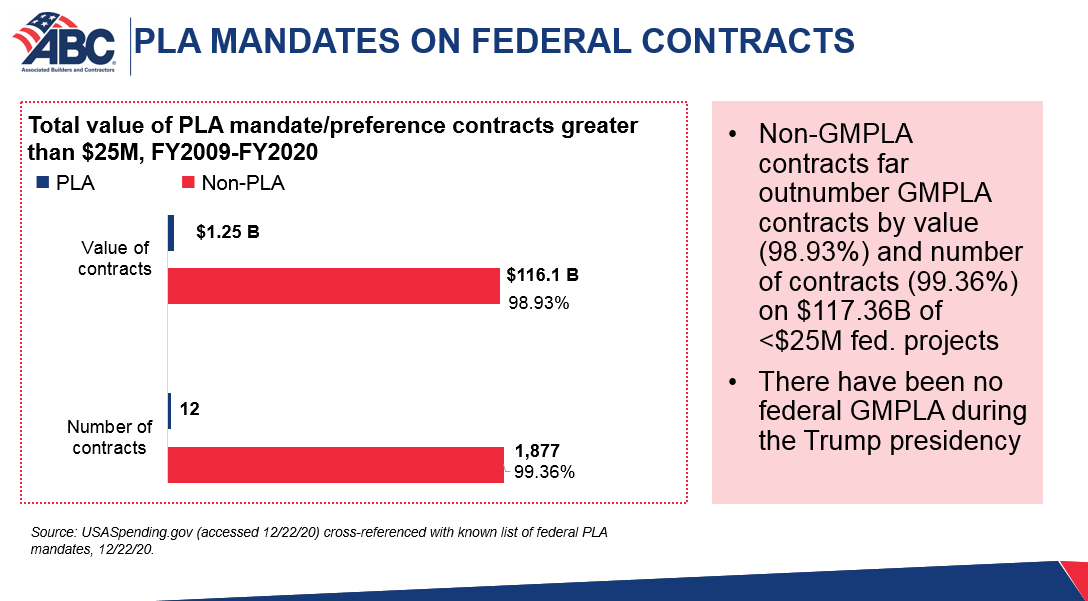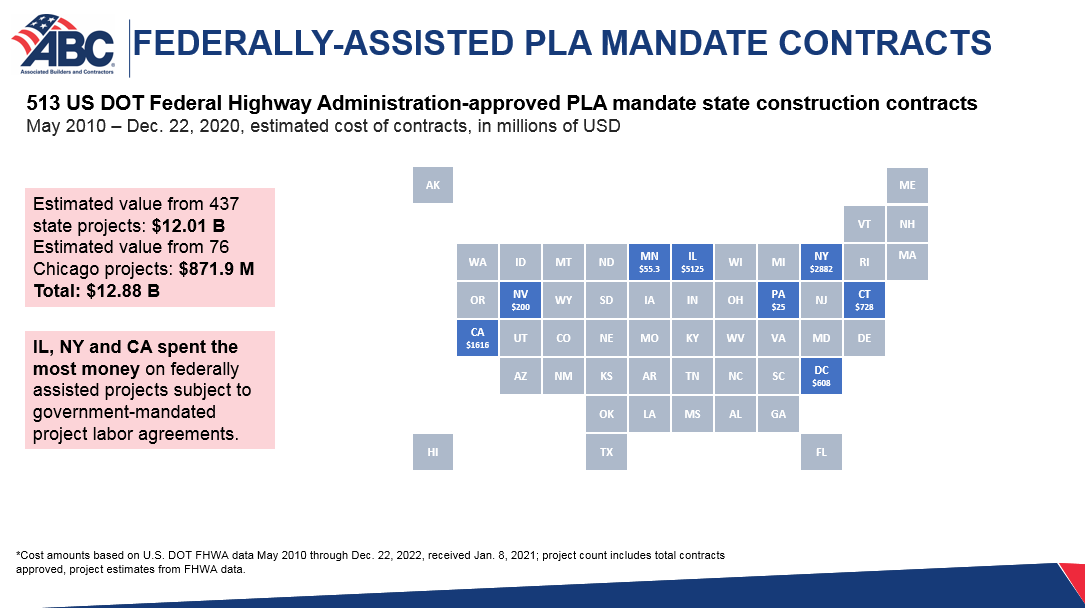Government-Mandated Project Labor Agreement Failures on Federal and Federally Assisted Construction Projects
ABC supports fair and open competition and opposes government-mandated project labor agreements on federal and federally assisted projects because hardworking taxpayers deserve more efficient and effective policies that will encourage all qualified contractors and their skilled workforce to compete to build long-lasting, quality projects at the best price.
Just 12.7% of the U.S. construction workforce belongs to a union, according to the Bureau of Labor Statistics—a steep decline from when union members made up more than 80% of the U.S. construction workforce in the 1940s. In an effort to stop decades of declining membership, in the last thirty years construction trade union lobbyists have turned to their buddies in government to mandate PLAs on public works projects to help them win market share and increase union membership.
In February 2009, former President Obama signed Executive Order 13502, which encourages federal agencies to mandate PLAs on large-scale federal construction projects exceeding $25 million in total cost on a case-by-case basis, and permits recipients of federal assistance to mandate PLAs on state and local public works projects. A handful of states and dozens of municipalities have passed laws encouraging the use of government-mandated PLAs on state and local public works projects.
There is concern that the 117th Congress and/or the Biden administration might expand the use of government-mandated PLAs on federal and federally assisted construction projects.
Such policies promoting PLA mandates are a bad deal for hardworking taxpayers and the construction industry, because PLA mandates increase construction costs by 12% to 20%, rig the bidding process to discourage experienced nonunion and union contractors and their qualified workforce from competing to build transformational taxpayer-funded projects and deny good-paying, local jobs to the more than 87% of the U.S. construction industry workers who chose not to affiliate with unions.
Problematic terms in government-mandated PLAs discourage competition from union and nonunion contractors and result in a rigged bidding process that forces contractors to:
- Use union hiring halls to obtain most or all workers instead of their existing workforce.
- Obtain apprentices exclusively from union apprenticeship programs.
- Follow inefficient union work rules.
- Pay into union benefit and multi-employer pension plans that any limited number of nonunion employees permitted on the project will be unlikely to access unless they join a union and vest in these plans.
- Require their existing workforce to accept union representation, pay union dues and/or join a union as a condition of employment on a PLA jobsite and receiving benefits, resulting in an estimated 20% hit to the paychecks of local craft professionals.
Union lobbyists justify “pay-to-PLA” schemes and government policies with compelling arguments and misinformation. They contend PLAs—master collective bargaining agreements with multiple construction unions governing a construction project—are a tool to prevent union strikes, ensure the use of local labor and deliver projects safely, on time and on budget. But the truth is these goals can and have been achieved without anti-competitive and costly government-mandated PLAs.
In fact, recent government-mandated PLAs on federal and federally assisted projects have resulted in litigation, reduced competition, increased costs, needless delays and poor local hiring outcomes, undermining pro-PLA arguments made by PLA advocates.
Government-Mandated PLA Failures on Federal Projects
While government-mandated PLAs on federal construction contracts have been limited since 2009 thanks to ABC’s advocacy efforts, when PLAs were attempted, they did not deliver on their promises on multiple projects.

An Obama administration U.S Department of Labor project demonstrates the anti-competitive and costly problems with PLA mandates on large-scale federal contracts.
A solicitation for a U.S. DOL Job Corps Center in Manchester, New Hampshire, was originally issued with a PLA mandate. After nearly three years of PLA-related delays and litigation, the project was rebid with a PLA and then again without a PLA following a successful GAO bid protest against the PLA.
Comparing the project’s 2013 bid results with and without a PLA suggests that PLA mandates increase costs and reduce competition. Without a PLA, there were more than three times as many bidders and the lowest bidder’s offer was $6,247,000 (16.47%) less than the lowest PLA bidder. In addition, firms who participated in both rounds of bidding submitted an offer that was nearly 10% less than when they submitted a bid with a PLA. The low bidder under the PLA mandate was from Florida, but without a PLA, a local firm from New Hampshire won the contract and completed it on time and on budget to the satisfaction of the DOL.
In addition, in 2010, the General Services Administration awarded a $52.3 million federal contract to build the Lafayette Building in Washington, D.C., but then forced the contractor to sign a change order and build it with a union-favoring PLA that cost taxpayers an additional $3.3 million.
Another GSA project, its headquarters building at 1800 F St. in Washington, D.C., suffered a 107-day delay and millions of dollars in cost increases as a result of failed PLA negotiations by labor unions and the contractor.
In 2013, data collected by Del. Eleanor Holmes-Norton (D) on federal projects subject to PLA mandates located in the District of Columbia demonstrated that PLAs delivered worse local hiring outcomes than other large-scale federal projects not subject to a PLA.
Government-Mandated PLA Failures on Federally Assisted Projects
The extent of the use of government-mandated PLAs on federally assisted projects is unknown, but snapshots of data suggest it is significant.
For example, according to a U.S. Department of Transportation Federal Highway Administration January 2021 report, state and local lawmakers mandated PLAs on 513 state and local construction projects, totaling an estimated $12.88 billion, which received federal assistance and formal approval from the FHWA.

Like their federal construction counterparts, many federally assisted construction projects subjected to PLA mandates by state and local governments have failed to deliver on promises made by PLA advocates.
In 2019, a Commonwealth Court of Pennsylvania’s Jan. 11 decision struck down PennDOT’s PLA mandate for the Markley Street reconstruction project in Montgomery County, Penn. Receiving financial assistance from the U.S. Department of Transportation’s Federal Highway Administration, the elimination of the project’s PLA mandate saved federal and state taxpayers an estimated $4.7 million, representing nearly a 20% savings. The court found the three lowest bidders on the job were all effectively precluded from bidding under the original bid solicitation containing a PLA. After the lowest PLA bidder withdrew and the state dropped their appeal, plaintiff Allan Myers was the low bidder and was awarded the work for $23.9 million.
New York’s Tappan Zee Bridge replacement, officially named the Governor Mario M. Cuomo Bridge, was supported by a mixture of U.S. FHWA, state, local and toll funding. It was projected to cost $3.14 billion, but it opened more than three months later than expected in 2018, at a cost of $3.98 billion. The project has recently been in the spotlight after media reports concluded the state downplayed a coverup of broken bolts a whistleblower flagged as compromising the structural integrity of the bridge. In 2016, a crane used for the construction of the bridge collapsed onto the existing older bridge. Five people were injured, including three drivers and two bridge workers. A 2014 decision to use robot welders because unions did not have enough manpower to complete the project, raised eyebrows because it took away jobs from qualified local nonunion labor excluded by the PLA.
The media called the federal, state and locally funded Highway 99 tunnel mega-project underneath Seattle’s downtown waterfront the West Coast’s “Big Dig,” named after Boston’s notoriously delayed and budget-busting series of tunnels and highway improvements that were also procured with a government-mandated PLA. It has been plagued by delays, cost overruns, union strikes, featherbedding and labor disputes, a poor safety record, employees working on the jobsite while drunk, sexual harassment allegations and violations of state and federal minority contracting rules.
The local, state and U.S. DOT Federal Transit Administration-funded Honolulu Rail Transit project has suffered significant delays and the final cost has grown from preliminary projections of $4 billion in 2006 to between $9 billion and $10 billion by 2017 and is expected to increase even more after the first phase of the project is projected to open in late 2021 and the second phase opens in December 2026.
Federally assisted projects that were part of the World Trade Center reconstruction following the 9/11 attacks in New York City suffered strikes in 2015, 2013 and 2011, despite no-strike promises contained in PLAs. The 4 World Trade Center jobsite suffered a crane accident in February 2012. In August 2012, the New York Post reported the Port Authority cracked down on drinking by construction union members following a series of accidents and reports of excessive workday boozing by union tradespeople employed at various World Trade Center construction projects, including 4 World Trade Center.
Beware of PLA Mandates on Federal and Federally Assisted Construction Projects
Americans are in strong bipartisan agreement that our nation’s roads, bridges, schools and water, energy and transportation systems are in urgent need of public and private investment in order to accelerate America’s strong economic comeback and keep our country competitive in a global economy.
As America’s infrastructure faces an estimated $2.6 trillion investment gap by 2029, the Biden administration and Congress are preparing to move a multitrillion dollar infrastructure bill. That’s good news for the U.S. economy and means new jobs for the construction industry, which faces a 9.6% unemployment rate due to the recession caused by the COVID-19 pandemic.
The truth is America simply cannot afford such waste and inefficiency with so many infrastructure and funding needs.
For these reasons, a total of 25 states outlaw government-mandated PLAs on public works projects, instead enacting more efficient and effective policies promoting fair and open competition on public works construction projects so hardworking taxpayers can get the highest quality construction project at the best possible price.
In February, Sen. Todd Young (R-Ind.) and Rep. Ted Budd (R-N.C.) introduced a broadly-supported bill, the Fair and Open Competition Act (S. 403/H.R. 1284), that would apply this commonsense policy to federal and federally assisted construction projects.
As America’s infrastructure may see its first major investment of taxpayer dollars and overhaul in decades, inclusive, win-win state and federal fair and open competition policies will ultimately result in savings to taxpayers and more opportunities for all qualified small businesses, minorities, veterans and women in the construction industry. This is the ideal way for the Biden administration and Congress to “Build Back Better” and create opportunities for all as we rebuild America together.











